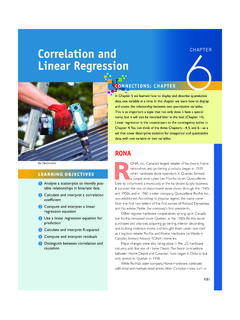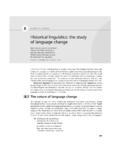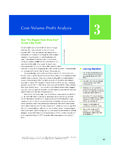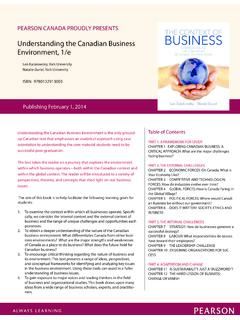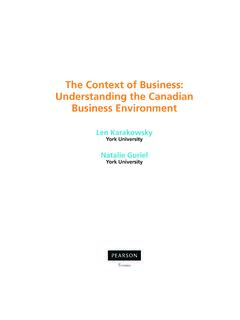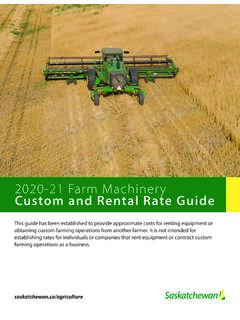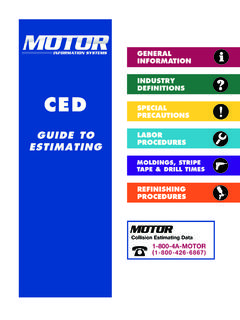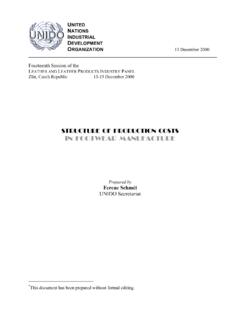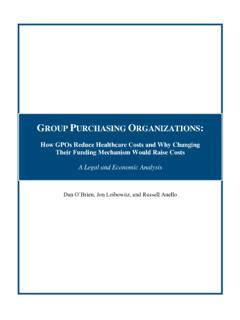Transcription of 6 Trade Discounts, Cash - The world's learning company
1 Trade Discounts, Cash Discounts, Markup, and MarkdownChapTer6 learning ObjeCTivesUpon completing this chapter, you will be able to do the following: Solve problems involving Trade discounts. Calculate equivalent single rates of discount for a discount series. Apply methods of cash discount. Solve problems involving markup based on either cost or selling price. Solve problems involving markdown. Solve integrated problems involving discounts, markup, and a business, traditional accounting profit is calculated by subtracting costs and expenses from sales revenue for a specified period. Determining a suitable selling price for each product or service is crucial for long-term sustainability. Some firms use a cost plus methodology, marking up the cost of each product or service by a certain percentage that is large enough to cover expenses and still leave a respectable profit.
2 Other organizations select their desired profit percentages first, and then work backwards to set their you were operating a bicycle shop and selling adult mountain bikes that cost $200 each from your supplier. Using a cost plus approach you might add a 20% markup to the cost of bikes sold in the shop in order to cover your additional expenses and make a profit. In this case, you would charge your customers $240 for the bikes, and your resulting profit percentage would be $40/$240 = 162 3%. If, however, you wanted to price the bikes in order to earn 20% profit, you would have to charge your customers $250 for the same bicycles ($50/$250 5 20%).ProfitSellingpriceWhen you mark up yourproducts to include Expensesand Profits, what is the Sellingprice? 20122/07/13 10:39 AM2nd ProofChApter 6 Trade DISCOUntS, CASh DISCOUntS, MArkUp, AnD MArkDOwn202 IntroductIonTh supply chain defi es the channels or stages that a product passes through as it is converted from a raw material to a fin shed product purchased by the consumer.
3 Figure outlines this the time the product is purchased by the consumer, the raw materials have been converted by the manufacturer, distributed through the wholesaler, and offered for sale by the retailer. In some supply chains, the distributor and wholesaler are separated. In other supply chains, the manufacturer also serves as the wholesaler. Within the supply chain, all of the channels must make a profit on the product to remain in channel applies a markup above its cost to buy the merchandise, which increases the price of the product. Sometimes a manufacturer or supplier sets a list price and then offers a Trade discount or a series of Trade discounts from that price to sell more product or to promote the product within the supply chain. Also, any of the channels within the sup-ply chain may offer a cash discount to encourage prompt payment for the product.
4 When the product is sold to the consumer, the regular selling price may be marked down or discounted to a sale price in response to competitors prices or other economic , cost, and expenses of a product determine the profit for that product. Understanding the relationships between these variables is crucial in maintaining a successful business. In this chapter, we will learn how to calculate the cost of products if Trade discounts are offered within the supply chain, as well as how to calculate the amount of cash to be paid when cash discounts are offered for early payment. We will also learn how to calculate price and profit when the cost is marked up, as well as the discounted price and resulting profit or loss when a product is offered on sale. ManufacturerWholesalerDistributorRetaile rConsumerA Supply ChainFigure terminology Used in the Supply Chainmarkup Manufacturer scostsNet price towholesalerCost towholesalerCost toretailer List Trade price discount(s)markup Net price toretailer List Trade price discount(s)markup markdownRegularsellingpriceSalepriceordi scountedpriceNet price toconsumerProfitSellingpriceIf a list price is set andtrade discounts areoffered, what is thecost?
5 20222/07/13 10:39 AM2nd DeterMInIng COSt wIth Trade DeTerMining COsT wiTh Trade DisCOUnTsa. Computing discount amounts, discount rate, net price, and list priceThe supply chain is made up of manufacturers , distributors, wholesalers, and retailers. Merchandise is usually bought and sold among the members of the chain on credit terms. The prices quoted to other members often involve Trade discounts. A Trade discount is a reduction of a list price or manufacturer s suggested retail price (MSRP) and is usually stated as a percent of the list price or discounts are used by manufacturers , distributors, and wholesalers as pric-ing tools for several reasons, such as to (a) determine different prices for different levels of the supply chain; (b) communicate changes in prices; (c) enable changes in computing a Trade discount, keep in mind that the rate of discount is based on the list DISCOUNT=RATE OF DISCOUNT LISTPRICEA=d L or A=dL Formula the amount of the discount and the discount rate are known, the list price can be determined.
6 Rearrange Formula to determine the list PRICE=AMOUNT OF DISCOUNTRATE OF DISCOUNT L=AdSince the rate of Trade discount is based on the list price, computing a rate of discount involves comparing the amount of discount to the list price. Rearrange Formula to determine the rate of Trade OF DISCOUNT=AMOUNT OF DISCOUNTLIST PRICE d=AL pOinTers anD piTFaLLsThis diagram is a useful aid in remember-ing the various forms of the amount of dis-count formula A 5 dL. Variables on the same line are multiplied together. Variables on different lines are example, in solving for d, note that A is above the L. Therefore, d 5 , L 5 20322/07/13 10:39 AM2nd ProofChApter 6 Trade DISCOUntS, CASh DISCOUntS, MArkUp, AnD MArkDOwn204Th net price is the remainder when the amount of discount is subtracted from the list price.
7 The net price is the price to the supplier, and becomes the cost to the PRICE=LIST PRICE AMOUNT OF DISCOUNTN=L A Formula compute the amount of the discount and the net price when the list price and discount rate are known, fi st apply Formula to determine the amount of the Trade discount, and then apply Formula to calculate the net price. exaMpLe An item listed at $ is subject to a Trade discount of 25%.Compute (i) the amount of discount; (ii) the net price. sOLUTiOn (i) Amount of Trade discount 5 Rate of discount 3 List price5 ( )( ) 5 $ (ii) Net price 5 List price 2 Trade discount5 2 5 $ exaMpLe The 30% discount on a tennis racket amounts to $ (i) the list price; (ii) the net price. sOLUTiOn (i) List price=Amount of discountRate of discount= $ (ii) Net price 5 List price 2 Amount of discount5 2 5 $ exaMpLe Find the rate of discount for (i) snowboards listed at $ less a discount of $ ; (ii) snow-sport helmets listed at $ whose net price is $ ; (iii) goalie pads whose net price is $ after a discount of $ sOLUTiOn (i) Rate of discount=Amount of discountList Price= (ii) Since Net price 5 List price 2 Amount of discount (Formula ),Amount of discount 5 List price 2 Net price 5 2 5 $ of discount=Amount of discountList price= 20422/07/13 10:39 AM2nd DeterMInIng COSt wIth Trade DISCOUntS205b.
8 The net price factor approachInstead of computing the amount of discount and then deducting this amount from the list price, the net price can be found by using the more effici t net factor approach developed in the following back to Example , the solution can be restated as follows: (iii) Since Net price 5 List price 2 Amount of discount (Formula ),List price 5 Net price 1 Amount of discount 5 1 5 $ of discount=Amount of discountList price= price $ Trade discount 25% of price $ the discount is given as a percent of the list price, the three dollar values may be stated as percents of list price:List price $ 100% of list priceLess Trade discount 25% of list pricenet price $ 75% of list priceNote: The resulting 75% is called the net price factor or net factor (in abbreviated form NPF) and is obtained by deducting the 25% discount from 100%.
9 NET PRICEFACTOR (NPF)=100% % DISCOUNTThe resulting relationship between net price and list price may be stated PRICE=LIST PRICE NET PRICEFACTOR (NPF) These relationships can be restated in algebraic terms:Convert the % discount into its decimal equivalent represented by d, and express 100% by its decimal equivalent, PRICE FACTOR=1 dLet the list price be represented by L, and let the net price be represented by (1 d) Formula way to derive the net price formula is to substitute Formula into Formula and then collect the similar terms. If we substitute Amount of discount, A 5 dL, into N 5 L 2 A, we obtain N 5 L 2 dL. Since L is a common factor, we can rewrite the formula as N 5 L(1 2 d). exaMpLe Find the net price for (i) list price $ less 15%; (ii) list price $ less 3313%.
10 20522/07/13 10:39 AM2nd ProofChApter 6 Trade DISCOUntS, CASh DISCOUntS, MArkUp, AnD MArkDOwn206C. Discount seriesA manufacturer may offer two or more discounts to different members of the supply chain. If a list price is subject to two or more discounts, these discounts are called a discount series. For example, a chain member closest to the consumer might be offered additional discounts if there are fewer chain members who must make a profit on an item. If the manufacturer wants to encourage large-volume orders or early orders of sea-sonal items, it may offer additional discounts. For example, a manufacturer might offer a retailer a 5% discount on orders over 1000 items and an additional discount of 6% for ordering Christmas items in April. It may also offer additional discounts to compensate for advertising, promotion, and service costs handled by supply chain computing the net price, the discounts making up the discount series are applied to the list price successively.
